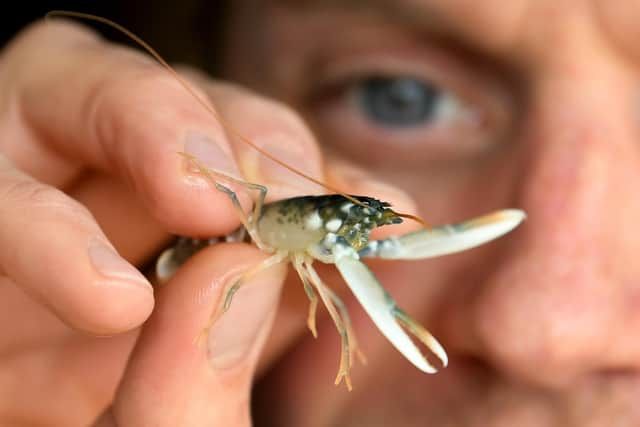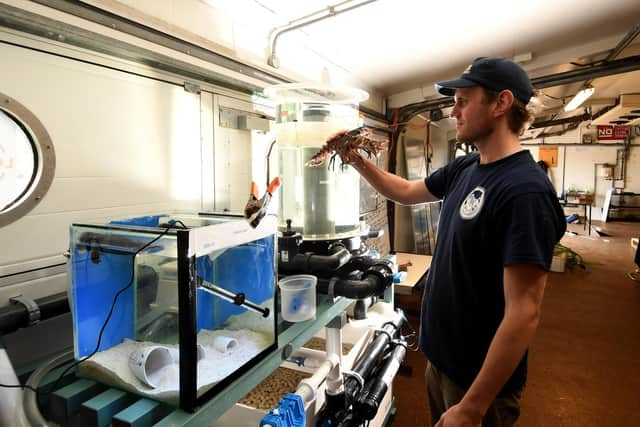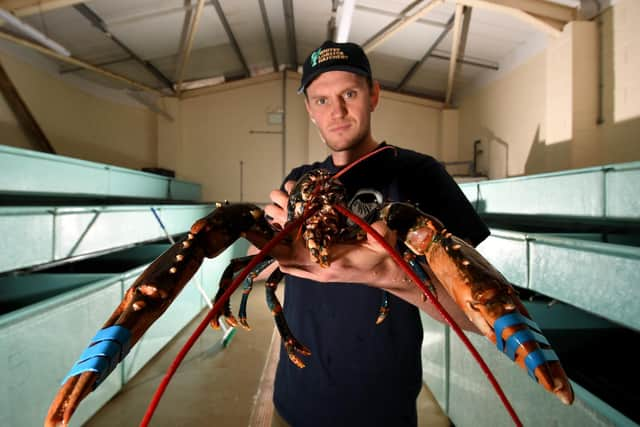Whitby Lobster Hatchery: Inside the conservation project that aims to restore shellfish stocks off the Yorkshire coast
The lobsters, which are only around an inch long, were donated by a hatchery in Scotland, while the Whitby hatchery carries on raising the money they need for the equipment needed to hatch their own.
Joe Redfern, who has a masters in marine biology, worked for the conservation authority and as a fisherman, is running the project, which also involves an interactive, educational Marine Discovery Centre based in the disused section of Whitby’s fish auction shed.
Advertisement
Hide AdAdvertisement
Hide AdFew people realise it but Whitby is Europe’s third largest lobster port - Bridlington is number one and Scarborough second.Fishermen turned to shellfish as catches of cod, haddock, whiting and flatfish dwindled through overfishing.


Now around 100,000 lobsters are landed into Whitby every year - the same number the hatchery hopes to replace..
The hatchery is launching a new crowdfunding bid to raise £24,000 for the deposit for vital equipment to hatch eggs from lobsters caught by local fishermen.
Joe says a hatchery is now needed “more than ever” given the number of dead shellfish that have been washing ashore on the Yorkshire and North East coasts since last October.
Advertisement
Hide AdAdvertisement
Hide AdThe Government has ruled out chemical pollution, sewage, animal disease, and dredging, although Joe believes it is linked with dredging and historical chemicals being disturbed.


He said restocking would be “part of the solution” to the problems fishermen are facing, and “ensuring we have a sustainable and secure fishing community for future generations”.
A fundraiser last year raised over £20,000, and helped kick start the project, however the equipment, food and power, needed to hatch 100,000 eggs will cost around £200,000.
For a juvenile lobster freefloating in the water their chances of survival are very slim - just one per cent.
Advertisement
Hide AdAdvertisement
Hide AdIn the hatchery they will be safe for the two or three months when they are at their most vulnerable and where they can grow to a size where they have proper claws and can protect themselves. That should increase their survival rate to 30 or 40 per cent.


Joe is hopeful that the money can be raised and says they’ve had great support so far.
“Yorkshire is Europe’s lobster capital. You tell that fact to everybody, but people don’t realise we have got lobsters, never mind the three biggest lobster fisheries, with relatively shallow seas and rocky grounds that are ideal.”
The majority of the delicious shellfish landed in ports up and down Yorkshire’s coast ends up gracing the tables of restaurants and hotels in Spain, France and Portugal. Holidaymakers dining on Breton Bleu in France might be surprised to realise it actually comes from Yorkshire.
Advertisement
Hide AdAdvertisement
Hide AdThose nations “value the quality of the product and it goes for a much higher price” academics previously told The Yorkshire Post.
In the UK, however, people are conditioned to cheap supermarket prices for frozen Canadian lobster. There is a market for fresh products - but usually only high-end restaurants and hotels.
In the 1990s there were 27 boats catching cod and haddock, out of Whitby, but by 2005 there was only one left.
The remaining boat, Atlas, still operates out of the port, but doesn’t fish any more, instead doing guard duty for the wind farms.
Advertisement
Hide AdAdvertisement
Hide AdThese days an incredible 300,000 pots are put out by fishermen along the North Eastern Inshore Fisheries and Conservation Authority area, which stretches from the River Tyne in the north to Spurn Point in the south.
Joe said: “In the last 15 years there has been a 400 per cent increase in lobsters landing into Whitby, all the fishing effort has moved into crabs and lobsters.
“An average 100,000 are landed into Whitby and the idea of the hatchery is to offset that average by releasing the 100,000.”
Comment Guidelines
National World encourages reader discussion on our stories. User feedback, insights and back-and-forth exchanges add a rich layer of context to reporting. Please review our Community Guidelines before commenting.